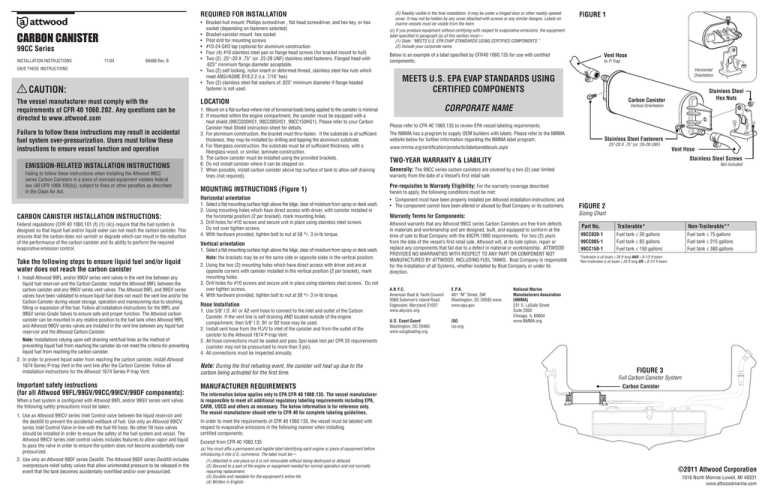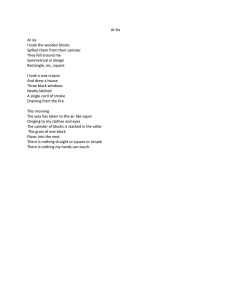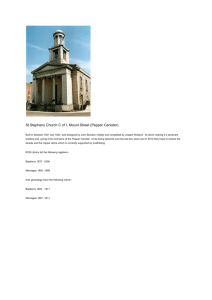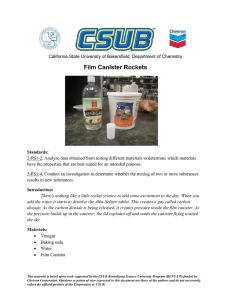carbon canister - Attwood Marine Products
advertisement

REQUIRED FOR INSTALLATION CARBON CANISTER 99CC Series INSTALLATION INSTRUCTIONS 11/04 69488 Rev. B SAVE THESE INSTRUCTIONS CAUTION: The vessel manufacturer must comply with the requirements of CFR 40 1060.202. Any questions can be directed to www.attwood.com Failure to follow these instructions may result in accidental fuel system over-pressurization. Users must follow these instructions to ensure vessel function and operation EMISSION-RELATED INSTALLATION INSTRUCTIONS Failing to follow these instructions when installing the Attwood 99CC series Carbon Canisters in a piece of nonroad equipment violates federal law (40 CFR 1068.105(b)), subject to fines or other penalties as described in the Clean Air Act. CARBON CANISTER INSTALLATION INSTRUCTIONS: Federal regulations (CFR 40 1060.101 (f) (1) (iii)) require that the fuel system is designed so that liquid fuel and/or liquid water can not reach the carbon canister. This ensures that the carbon does not varnish or degrade which can result in the reduction of the performance of the carbon canister and its ability to perform the required evaporative emission control. Take the following steps to ensure liquid fuel and/or liquid water does not reach the carbon canister 1. Install Attwood 99FL and/or 99GV series vent valves in the vent line between any liquid fuel reservoir and the Carbon Canister. Install the Attwood 99FL between the carbon canister and any 99GV series vent valves. The Attwood 99FL and 99GV series valves have been validated to ensure liquid fuel does not reach the vent line and/or the Carbon Canister during vessel storage, operation and maneuvering due to sloshing, filling or expansion of the fuel. Follow all installation instructions for the 99FL and 99GV series Grade Valves to ensure safe and proper function. The Attwood carbon canister can be mounted in any relative position to the fuel tank when Attwood 99FL and Attwood 99GV series valves are installed in the vent line between any liquid fuel reservoir and the Attwood Carbon Canister. Note: Installations relying upon self draining vent/fuel lines as the method of preventing liquid fuel from reaching the canister do not meet the criteria for preventing liquid fuel from reaching the carbon canister. 2. In order to prevent liquid water from reaching the carbon canister, install Attwood 1674 Series P-trap Vent in the vent line after the Carbon Canister. Follow all installation instructions for the Attwood 1674 Series P-trap Vent. Important safety instructions (for all Attwood 99FL/99GV/99CC/99ICV/99DF components): When a fuel system is configured with Attwood 99FL and/or 99GV series vent valves the following safety precautions must be taken; 1. Use an Attwood 99ICV series Inlet Control valve between the liquid reservoir and the deckfill to prevent the accidental wellback of fuel. Use only an Attwood 99ICV series Inlet Control Valve in-line with the fuel fill hose. No other fill hose valves should be installed in order to ensure the safety of the fuel system and vessel. The Attwood 99ICV series inlet control valves includes features to allow vapor and liquid to pass the valve in order to ensure the system does not become accidentally over pressurized. 2. Use only an Attwood 99DF series Deckfill. The Attwood 99DF series Deckfill includes overpressure relief safety valves that allow unintended pressure to be released in the event that the tank becomes accidentally overfilled and/or over pressurized. • Bracket-hull mount: Phillips screwdriver , flat head screwdriver, and hex key, or hex socket (depending on fasteners selected) • Bracket-canister mount: hex socket • Pilot drill for mounting screws • #10-24 GH3 tap (optional for aluminum construction • Four (4) #10 stainless steel pan or flange head screws (for bracket mount to hull) • Two (2) .25"-20 X .75" (or .25-28 UNF) stainless steel fasteners. Flanged head with .625" minimum flange diameter acceptable. • Two (2) self locking, nylon insert or deformed thread, stainless steel hex nuts which meet ANSI/ASME B18.2.2 (i.e. 7/16" hex) • Two (2) stainless steel flat washers of .625" minimum diameter if flange headed fastener is not used. (5) Readily visible in the final installation. It may be under a hinged door or other readily opened cover. It may not be hidden by any cover attached with screws or any similar designs. Labels on marine vessels must be visible from the helm. (c) If you produce equipment without certifying with respect to evaporative emissions, the equipment label specified in paragraph (a) of this section must— (1) State: ‘‘MEETS U.S. EPA EVAP STANDARDS USING CERTIFIED COMPONENTS.’’ (2) Include your corporate name. Below is an example of a label specified by CFR40 1060.135 for use with certified components; MOUNTING INSTRUCTIONS (Figure 1) Horizontal orientation 1. Select a flat mounting surface high above the bilge, clear of moisture from spray or deck wash. 2. Using mounting holes which have direct access with driver, with canister installed in the horizontal position (2 per bracket), mark mounting holes. 3. Drill holes for #10 screws and secure unit in place using stainless steel screws. Do not over tighten screws. 4. With hardware provided, tighten bolt to nut at 58 +/- 3 in-lb torque. Vertical orientation 1. Select a flat mounting surface high above the bilge, clear of moisture from spray or deck wash. Note: the brackets may be on the same side or opposite sides in the vertical position. 2. Using the two (2) mounting holes which have direct access with driver and are at opposite corners with canister installed in the vertical position (2 per bracket), mark mounting holes. 3. Drill holes for #10 screws and secure unit in place using stainless steel screws. Do not over tighten screws. 4. With hardware provided, tighten bolt to nut at 58 +/- 3 in-lb torque. Hose Installation 1. Use 5/8" I.D. A1 or A2 vent hose to connect to the inlet and outlet of the Carbon Canister. If the vent line is self draining AND located outside of the engine. compartment, then 5/8" I.D. B1 or B2 hose may be used. 2. Install vent hose from the FLVV to inlet of the canister and from the outlet of the canister to the Attwood 1674 P-trap Vent. 3. All hose connections must be sealed and pass 3psi leask test per CFR 33 requirements (canister may not be pressurized to more than 3 psi). 4. All connections must be inspected annually. Note: During the first refueling event, the canister will heat up due to the carbon being activated for the first time. MANUFACTURER REQUIREMENTS Vent Hose to P-Trap Horizontal Orientation MEETS U.S. EPA EVAP STANDARDS USING CERTIFIED COMPONENTS LOCATION 1. Mount on a flat surface where risk of torsional loads being applied to the canister is minimal 2. If mounted within the engine compartment, the canister must be equipped with a heat shield (99CC030HS1, 99CC085HS1, 99CC150HS1). Please refer to your Carbon Canister Heat Shield instruction sheet for details. 3. For aluminum construction, the bracket must thru-fasten. If the substrate is of sufficient thickness, they may be installed by drilling and tapping the aluminum substrate. 4. For fiberglass construction, the substrate must be of sufficient thickness, with a fiberglass-wood, or similar, laminate construction. 5. The carbon canister must be installed using the provided brackets. 6. Do not install canister where it can be stepped on. 7. When possible, install carbon canister above top surface of tank to allow self draining lines (not required). FIGURE 1 Stainless Steel Hex Nuts Carbon Canister CORPORATE NAME Vertical Orientation Please refer to CFR 40 1060.135 to review EPA vessel labeling requirements. The NMMA has a program to supply OEM builders with labels. Please refer to the NMMA website below for further information regarding the NMMA label program; Stainless Steel Fasteners .25"-20 X .75" (or .25-28 UNF) www.nmma.org/certification/products/labelsanddecals.aspx Vent Hose Stainless Steel Screws TWO-YEAR WARRANTY & LIABILITY Not included Generally: The 99CC series carbon canisters are covered by a two (2) year limited warranty from the date of a Vessel’s first retail sale. Pre-requisites to Warranty Eligibility: For the warranty coverage described herein to apply, the following conditions must be met: • Component must have been properly installed per Attwood installation instructions; and • The component cannot have been altered or abused by Boat Company or its customers. Attwood warrants that any Attwood 99CC series Carbon Canisters are free from defects in materials and workmanship and are designed, built, and equipped to conform at the time of sale to Boat Company with the 40CFR.1060 requirements. For two (2) years from the date of the vessel’s first retail sale, Attwood will, at its sole option, repair or replace any components that fail due to a defect in material or workmanship. ATTWOOD PROVIDES NO WARRANTIES WITH RESPECT TO ANY PART OR COMPONENT NOT MANUFACTURED BY ATTWOOD, INCLUDING FUEL TANKS. Boat Company is responsible for the installation of all Systems, whether installed by Boat Company or under its direction. A.B.Y.C. American Boat & Yacht Council 3069 Solomon’s Island Road Edgewater, Maryland 21037 www.abycinc.org E.P.A. 401 “M” Street, SW Washington, DC 20593 www. www.epa.gov U.S. Coast Guard Washington, DC 20460 www.uscgboating.org ISO iso.org FIGURE 2 Sizing Chart Warranty Terms for Components: Part No. Trailerable* Non-Trailerable** 99CC030-1 99CC085-1 99CC150-1 Fuel tank ≤ 30 gallons Fuel tank ≤ 85 gallons Fuel tank ≤ 150 gallons Fuel tank ≤ 75 gallons Fuel tank ≤ 215 gallons Fuel tank ≤ 380 gallons *Trailerable is all boats < 26 ft long AND < 8-1/2 ft beam *Non-trailerable is all boats > 26 ft long OR > 8-1/2 ft beam National Marine Manufacturers Association (NMMA) 231 S. LaSalle Street Suite 2050 Chicago, IL 60604 www.NMMA.org FIGURE 3 Full Carbon Canister System Carbon Canister The information below applies only to EPA CFR 40 1060.135. The vessel manufacturer is responsible to meet all additional regulatory labeling requirements including EPA, CARB, USCG and others as necessary. The below information is for reference only. The vessel manufacturer should refer to CFR 40 for complete labeling guidelines. In order to meet the requirements of CFR 40 1060.135, the vessel must be labeled with respect to evaporative emissions in the following manner when installing certified components; Excerpt from CFR 40 1060.135 (a) You must affix a permanent and legible label identifying each engine or piece of equipment before introducing it into U.S. commerce. The label must be— (1) Attached in one piece so it is not removable without being destroyed or defaced. (2) Secured to a part of the engine or equipment needed for normal operation and not normally requiring replacement. (3) Durable and readable for the equipment’s entire life. (4) Written in English. ©2011 Attwood Corporation 1016 North Monroe Lowell, MI 49331 www.attwoodmarine.com


